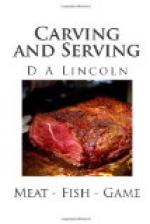THE BACK OF THE RUMP.
A roast from the back of the rump, if cooked without removing the bone, should be placed on the platter with the backbone on the farther side. Cut first underneath to loosen the meat from the bone. Then, if the family be large and all the meat is to be used, the slices may be cut lengthwise; but should only a small quantity be needed, cut crosswise and only from the small end. It is then in better shape for the second day.
It is more economical to serve the poorer parts the first day, as they are never better than when hot and freshly cooked. Reserve the more tender meat to be served cold.
FILLET OF BEEF OR TENDERLOIN.
Before cooking, remove all the fat, and every fibre of the tough white membrane. Press it into shape again and lard it, or cover it with its own fat. If this fibre be not removed, the sharpest knife will fail to cut through it. Place it on the platter with the larger end at the right; or if two short fillets be used, place the thickest ends in the middle. Carve from the thickest part, in thin, uniform slices.
ROUND OF BEEF, FILLET OF VEAL, OR FRICANDEAU OF VEAL.
These are placed on the platter, flesh side up, and carved in horizontal slices, care being taken to carve evenly, so that the portion remaining may be in good shape. As the whole of the browned outside comes off with the first slices, divide this into small pieces, to be served if desired with the rare, juicy, inside slices.
BEEFSTEAK.
It may seem needless to direct one how to carve a sirloin steak, but it sometimes appears to require more skill than to carve poultry, as those who have been so unfortunate as to receive only the flank can testify.
I believe most strongly, as a matter of economy, in removing the bone, and any tough membrane or gristle that will not be eaten, before cooking the steak. If there be a large portion of the flank, cook that in some other way. With a small, sharp knife cut close to the rib on each side, round the backbone, and remove the tough white membrane on the edge of the tenderloin. Leave the fat on the upper edge, and the kidney fat also, or a part of it, if it be very thick. There need be no waste or escape of juices if the cutting be done quickly, neatly, and just before cooking. Press the tenderloin—that is, the small portion on the under side of the bone—close to the upper part, that the shape may not be changed.
In serving place it on the dish with the tenderloin next to the carver. Cut in long narrow strips from the fat edge down through the tenderloin. Give each person a bit of tenderloin, upper part, and fat. If the bone be not removed before cooking, remove the tenderloin first by cutting close to the bone, and divide it into narrow pieces; then remove the meat from the upper side of the bone and cut in the same manner. A long, narrow strip about as wide as the steak is thick is much more easily managed on one’s plate than a square piece. Serve small portions, and then, if more be desired, help again.




